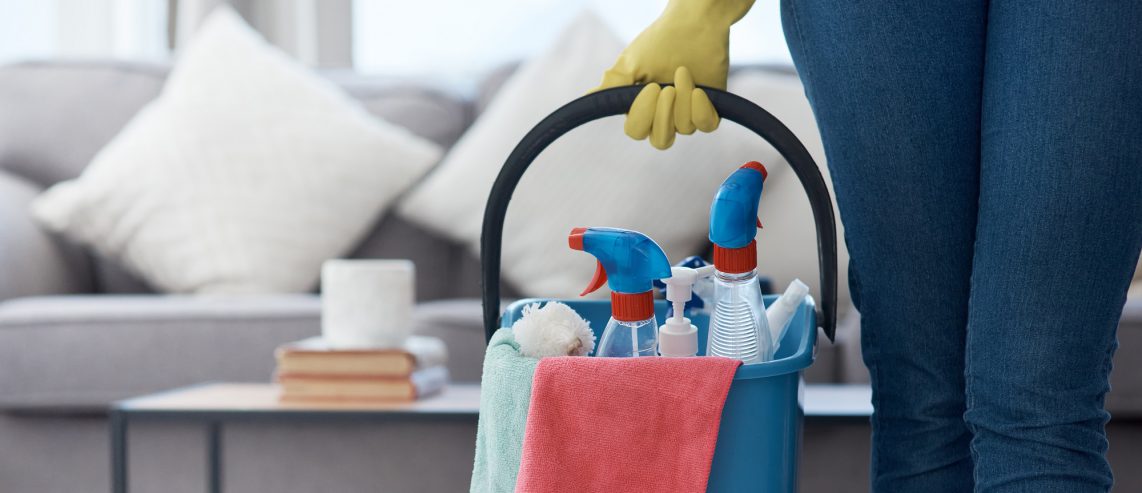You’re doing a deep clean of your bathroom when you accidentally splash some bleach on your skin. Should you worry? And what is the best treatment for bleach spills?
“Accidental spillage of bleach can happen in any household, says Sai Swapnika Guttikonda, MD; Franklin Community Medicine-UPMC. “It would be dangerous, especially with kids at home. Knowing how to act immediately and what to do before reaching out to the physician will help mitigate damage to the skin, eyes, and mucus membranes,” add Dr. Guttikonda.
Bleach Basics
Bleach is a useful disinfectant for many household applications. It can kill most viruses and bacteria. It can also get rid of mold and mildew.
Manufacturers add bleach to cleaning products, and people use bleach to make their white clothes look whiter.
But bleach is also dangerous to inhale, ingest, or get on your skin. At low levels, it can irritate your skin and mucous membranes. But at higher strength, bleach can cause a chemical burn to human tissue.
If you mix bleach with other household cleansers (like toilet bowl or drain cleaners), the resulting fumes can be toxic. At low levels, these fumes may cause coughing, watery eyes, and a runny nose. Higher levels can cause chest pain, breathing problems, and even death.
Never Miss a Beat!
Subscribe to Our HealthBeat Newsletter!
Thank you for subscribing!
You can now select the specific newsletters you'd like to receive.
You are already subscribed.
Subscribe to more newsletters in our email preference center.
Sorry, an error occurred. Please try again later.
Get Healthy Tips Sent to Your Phone!
General Safety Tips for Working With Bleach
Bleach has many household uses, and it’s a good way to disinfect kitchens and bathrooms. But you should always follow the following safety tips to avoid accidents.
- Never mix bleach with ammonia or any other cleansers. Bleach combined with ammonia can create a toxic gas.
- Wear rubber gloves when you clean with bleach.
- Wear goggles to protect your eyes when working with bleach.
- Keep the area well-ventilated. If you’re cleaning with bleach, open the windows and doors if you can. This will help you to avoid breathing in fumes.
- Store bleach well out of children’s reach.
- Consider using bleach alternatives like hydrogen peroxide, lemon juice, or white vinegar for whitening clothes or cleaning your house.
What to Do After Spilling Bleach on Your Skin
No matter how careful you are, accidents happen. Once you realize you’ve spilled bleach on your skin, you should take immediate action. Here’s what you should (and shouldn’t) do for a bleach burn.
- Flush the bleach off your skin with cool running water for at least 15 minutes.
- Apply cool, wet compresses to relieve any pain.
- Cover the affected area in a sterile bandage.
- Change the bandage once a day — or more often if it’s wet or dirty.
- Take over-the-counter non-steroidal anti-inflammatory drugs (NSAIDs) like ibuprofen to reduce pain and swelling.
- Don’t pop any blisters that may form. Blisters promote healing by protecting the wound and keeping bacteria out.
When to See a Doctor for Bleach on Skin Treatment
Most times, you can treat bleach accidents at home. If you got a little bleach on your skin, it’s unlikely to cause more than a minor irritation. But sometimes bleach spills can cause more problems.
You should call 911 or go to the emergency room immediately if someone:
- Gets bleach in their eyes.
- Spills bleach on a large portion of their body.
- Has trouble breathing after getting bleach on their skin.
- Is having seizures.
- Is unconscious.
Call the Poison Control Center at 1-800-222-1222 if you or a child accidentally swallows bleach. You can also use the Poison Control Center’s online tool for advice on what to do.
If your bleach burn doesn’t seem to be getting better after a few days, you should call your doctor. Redness, fever, or pus could be signs of infection.
Sources
CDC, Household Cleaning & Sanitizing, Link
National Library of Medicine, Bleach Toxicity, Link
National Library of Medicine, Chemical Burns, Link
Beyondtoxics.org, Bleaches, Laundry, Link
NHS, Acid and chemical burns, Link
Poison Control, Laundry Products, Link
National Library of Medicine, Chemical burn or reaction, Link
About UPMC
Headquartered in Pittsburgh, UPMC is a world-renowned health care provider and insurer. We operate 40 hospitals and 800 doctors’ offices and outpatient centers, with locations throughout Pennsylvania, Maryland, New York, West Virginia, and internationally. We employ 4,900 physicians, and we are leaders in clinical care, groundbreaking research, and treatment breakthroughs. U.S. News & World Report consistently ranks UPMC Presbyterian Shadyside as one of the nation’s best hospitals in many specialties and ranks UPMC Children’s Hospital of Pittsburgh on its Honor Roll of America’s Best Children’s Hospitals. We are dedicated to providing Life Changing Medicine to our communities.
